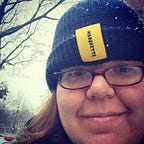Digital Storytelling: Preserving the Memory of the Elizabeth Plankinton Mansion
Each semester that it’s offered, students in documentary filmmaker Joe Brown’s “Craft of Digital Storytelling” (COMM6820) course learn how to develop their digital storytelling skills through the creation of photo, video, and audio stories. As the culmination of the class, they create a large media project of their own, a video or podcast or even a website combining both audio and video elements.
Eric Kowalik is the library’s Instructional Designer, and in his role he often consults or assists in creating digital or media objects for instructional purposes (like the library’s video tour, for example). He is also a graduate student in the College of Communication and took COMM 6820 last semester, where he created a digital narrative focusing on a part of Marquette University history that only those who have been around campus for quite some time would remember: the City of Milwaukee’s fight to save the Elizabeth Plankinton Mansion on the Marquette campus.
If you weren’t aware — and I certainly wasn’t — the Elizabeth Plankinton Mansion was one of the many luxurious houses built in Milwaukee’s early years, the mansions that gave Wisconsin Ave its first name, Grand Ave, for all the impressive homes that sat along it. The Pabst Mansion, snugly surrounded by Marquette’s expanding campus, is one of the few remaining examples of the houses that Milwaukee’s early industrial wealth built. Built on what is now the block of 14th and Wisconsin, the mansion is obviously no longer around. Over the years many of the old homes have been replaced by modern buildings as the city grew and changed. The AMU currently occupies the area where it was located, next to the old Jesuit Residence (torn down in 2015), just across the street from the Memorial side of the libraries.
But the story of how the last of the Plankinton mansions on Wisconsin Ave disappeared is the narrative that Eric shares in his video. The Elizabeth Plankinton mansion’s demolition is intrinsically tied to the intertwined histories of Marquette University and the city of Milwaukee over the past 130 years. Using archival footage provided by Marquette’s Special Collections and University Archives. with assistance from archivist Katie Blank, Eric’s video contextualizes the history of the home, the city, and the university, before exploring how the relationship between these three things changed as the city and the campus adapted to their growth and the needs of their people, ultimately leading to the demolition of the slightly unusual building in the heart of campus.
Eric researched the history of the mansion, from its construction beginning in 1886, through its use as a private home and then Knights of Columbus clubhouse, to the controversial demolition in the fall of 1980. He assembled still images and video footage of the home in Adobe Premiere Pro and recorded his narration over it. In the video, you’ll also see some interesting effects he created using Adobe After Effects, including a parallax technique that creates simulated motion within a still photograph, as well as a map and timeline he used to help illustrate the story of the building.
Digital media is a great way to tell a story, especially to tell a story that otherwise runs the risk of being forgotten. There are some still around campus who might remember the conflict over the Elizabeth Plankinton mansion’s removal, but most of us — even if we were around in 1980 — are probably unaware of the time that students protested the bulldozing of a building on campus, and the city fought to preserve it.
If you’d like to create a visual narrative like Eric has done here, the Digital Scholarship Lab has much to offer you. From cameras and tripods, to microphones and editing software, the Lab can help you create a video that will capture the story you are seeking to tell.
